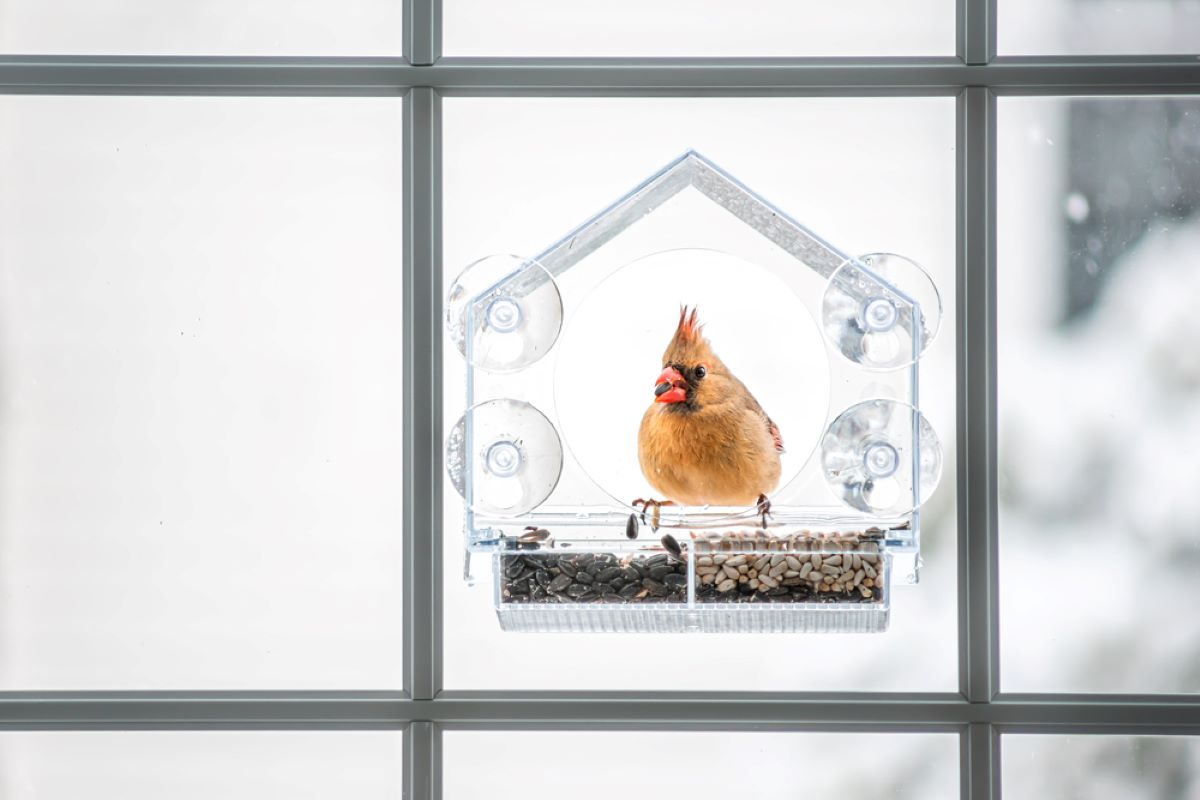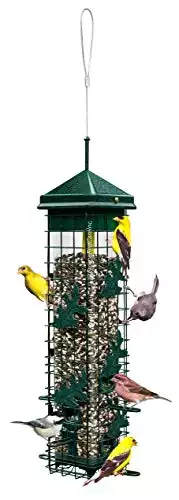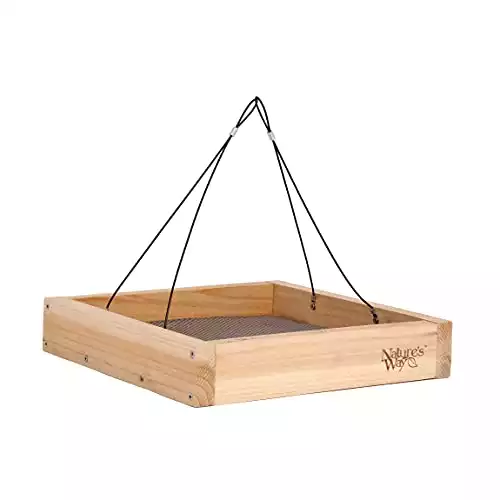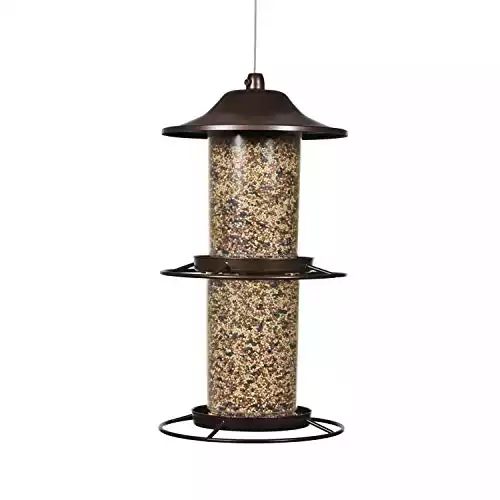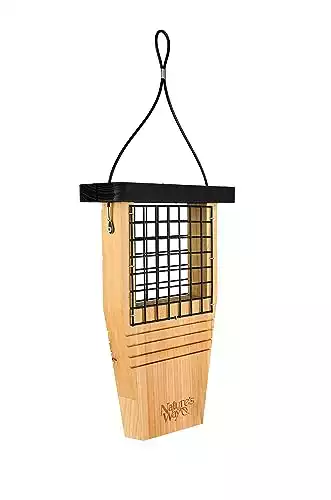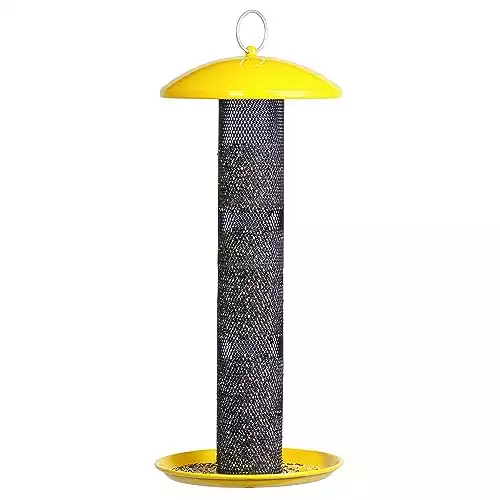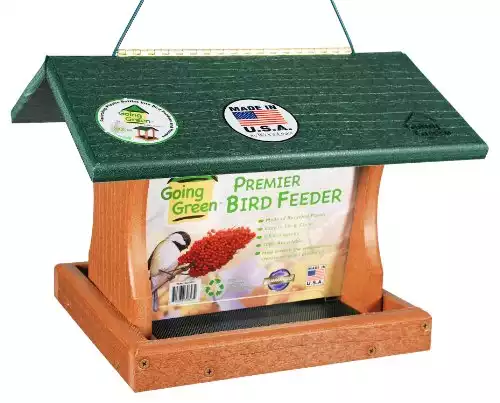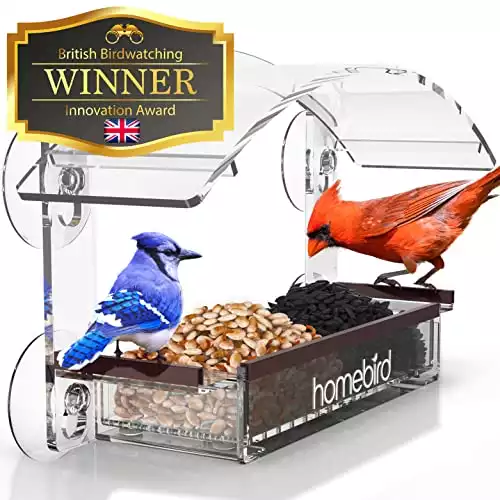Bird feeders are an ideal way of attracting more feathered friends to your backyard. You can pick between a tray feeder for birds or a window bird feeder, depending on the species that visit you. However, know that not all bird feeders are the same.
Here, you’ll learn more about attracting birds to a feeder, which feeders go with each species, and how you can mount them. Plus, you’ll see the options of keeping the feeders safe from mice, rats, and squirrels.
Below you will find our list of the best feeders available on Amazon or Home Depot.
Top 3 Comparison Table
|
|
|
|
|
Pros:
|
Pros:
|
Pros:
|
- Squirrel-proof design
- Very simple to clean and refill
- Lifetime warranty
- Natural cedar wood - weather-proof
- Large feeding area
- Versatile mounting options
- Circular perch and antique finish
- Sure-Lock cap system against squirrels
- Built-in seed tray
Our Top 7 Picks
1. Brome Squirrel Solution200 Bird Feeder
- Rust-proof hardware
- Chew-proof and UV-resistant materials
- Adjustable perches
- 6 feeding ports
- Squirrel-proof design
- Built-in seed ventilation
- Easy to clean and refill
- Lifetime warranty
This is an excellent option made with sturdy and durable materials, making it resistant to damage from birds and weather. The feeder is constructed with UV-resistant materials to withstand exposure to the sun and weather elements, ensuring its durability over time.
The feeder has 6 feeding ports, allowing multiple birds to feed simultaneously. This design attracts a variety of bird species to your backyard. The feeder features adjustable perches that allow you to control the size of birds that can access the ports. By adjusting the perches, you can exclude larger birds if desired.
The feeder is designed with an innovative squirrel-proof mechanism. When a squirrel or a larger bird tries to access the feeding ports, the weight of the animal closes off the ports, preventing them from reaching the seed.
The feeder is designed for easy cleaning and refilling. The top and bottom easily come apart, making maintenance a breeze.
With a seed capacity of 3.4 pounds, the Squirrel Solution200 can hold a substantial amount of birdseed, reducing the frequency of refills.
Pros
- Users appreciate the feeder’s squirrel-proof design, which effectively keeps squirrels and larger birds from accessing the birdseed
- The feeder’s user-friendly design, with easy-to-disassemble top and bottom parts, makes it simple to clean and refill
- The lifetime warranty offered by the manufacturer provides users with peace of mind
Cons
- One of the most expensive options on the market (however, it’s also worth the price)
2. Nature’s Way Cedar Platform Tray Bird Feeder
- Platform tray design
- Cedar construction
- Sustainable and eco-friendly
- Drainage holes
- Multiple mounting options
- Generous seed capacity
The feeder features a large flat tray platform that provides ample space for various bird foods, including seeds, nuts, fruits, and mealworms. The open design allows birds of different sizes and species to feed together. It attracts sparrows, finches, cardinals, jays, grosbeaks, woodpeckers, chickadees, towhees, and American robins.
This bird feeder is made from natural cedar wood, which is resistant to decay and insect damage. Cedar is also an attractive and durable material that blends well with outdoor environments. Cedar wood is a sustainable and eco-friendly choice for bird feeders, as it comes from a renewable resource.
The tray has a large 3-pound seed capacity and is equipped with drainage holes to prevent water from accumulating and keep the birdseed dry.
The removable tray makes it easy to clean and refill the bird feeder. It’s also easy to add squirrel baffles or domes to protect the birdseed from unwanted visitors like squirrels and larger birds.
Pros
- The natural cedar wood not only looks attractive but also withstands outdoor elements well, making it a long-lasting addition to the backyard
- The large feeding area accommodates different bird sizes and feeding preferences, allowing for a diverse range of birds to visit the feeder
- Users like that they can hang the feeder from a tree branch, hook, or pole using the attached hanging cable
Cons
- The open design allows rain or snow to reach the birdseed
3. Perky-Pet Outdoor Panorama Wild Bird Feeder
- Powder coated metal construction
- Circular perch design
- Built-in seed tray
- Sure-lock cap system
- Holds up to 2 pounds of seed
The Panorama Wild Bird Feeder features a circular perch design that allows birds to feed from all sides, providing easy access t.o the birdseed. This type of design attracts cardinals, titmice, nuthatches and more.
This feeder comes with a built-in seed tray at the bottom, which helps catch fallen seeds and reduces waste. It also provides additional feeding space for birds.
The feeder is equipped with a Sure-Lock cap system that securely locks the lid to prevent squirrels and other pests from accessing the birdseed.
The Panorama Feeder has a generous seed capacity, allowing you to fill it with up to 2 pounds of birdseed.
The antique finish gives the feeder a classic and timeless look, making it an eye-catching addition to any garden or outdoor space.
Pros
- Users love the feeder’s circular perch and antique finish
- Users who struggle with squirrel intrusions in their bird feeders will appreciate the Sure-Lock cap system
- The inclusion of a built-in seed tray is a convenient feature, as it catches fallen seeds, reduces waste
Cons
- While the feeder is designed to be weather-resistant, there were instances it did not hold up well over time
4. Nature’s Way Tail-prop Suet Bird Feeder
- Durable and weather-resistant
- High-energy food source
- Attracts clinging birds
- Year round use
- Easy to fill and clean
Suet feeders, including this model from Nature’s Way, are especially valuable during the colder months when birds need high-energy food sources to stay warm.
The feeder is made from poly lumber, a material created from recycled plastic jugs and bottles. Poly lumber is designed to be highly resistant to cracking, splitting, and fading, ensuring the feeder’s longevity and performance even in various weather conditions.
The feeder is equipped with a unique tail-prop design, which allows clinging birds to prop their tails against the feeder while feeding. This provides them with stability and comfort during feeding. The tail-prop design attracts woodpeckers, nuthatches, chickadees, and other clinging birds that enjoy feeding on suet.
The suet feeder’s hinged top makes it easy to open and fill with suet cakes. This is particularly convenient in winter when you may need to replenish the food more frequently due to increased bird activity.
The suet feeder has a hinged top or side, making it easy to open and fill with suet cakes. The design also facilitates easy cleaning, ensuring a hygienic feeding environment for the birds.
Pros
- Unique tail-prop design, which provides stability and comfort for clinging birds like woodpeckers while they feed
- The feeder’s materials are designed to prevent cracking, splitting, and fading
- Suet feeders are not limited to winter; they can be used year-round
Cons
- Suet feeders may accumulate bird droppings and other debris, making cleaning a more involved task
5. Perky-Pet Thistle Seed Tube Bird Feeder
- Specifically designed for dispensing thistle or nyjer seeds
- Wire mesh tube design
- Rust-resistant finish
- Evenseed tchnology
- Removable lid
- Large feeding area
The feeder is designed to dispense thistle or nyjer seeds, which are a favorite food for finches, including American goldfinches, house finches, and purple finches.
The feeder is constructed with a wire mesh tube, allowing birds to cling to the sides and extract the tiny thistle seeds. The wire mesh design also provides excellent ventilation to keep the seeds fresh.
It features Evenseed Technology, a mechanism that ensures a constant and consistent supply of thistle or nyjer seeds to the feeding ports. It prevents the seeds from getting stuck or clogged in one section of the feeder.
The straight-sided shape of the feeder allows more birds to feed simultaneously, offering a larger feeding area for finches.
The top lid us removable, making it easy to fill the feeder with thistle seeds (1.5lb capacity). The wire mesh design also allows for easy cleaning and seed level monitoring.
Pros
- Specifically designed to attract finches and other small birds, as finches are colorful and cheerful birds that add beauty and life to any backyard
- Evenseed Technology ensures consistent seed distribution, preventing clogging
- The wire mesh tube design allows finches to easily cling to the sides of the feeder and extract the tiny thistle seeds
Cons
- The design of the feeder might lead to seed spillage, especially during windy conditions or when finches are feeding vigorously
6. Woodlink Going Green Large Premier Bird Feeder
- Durable construction
- Recycled plastic
- Open seed tray
- Multiple feeding ports
- Drainage system
- Large feed capacity
- Hang cable included
Made of up to 90-percent post-consumer recycled plastic, this feeder promotes environmentally conscious bird feeding. Various songbirds, including sparrows, finches, chickadees, titmice, and nuthatches, are likely to visit this type feeder to feed on the seeds.
The ranch-style feeding trough offers multiple feeding stations, enabling several birds to feed simultaneously. The powder-coated metal screen bottom provides effective drainage, preventing water from accumulating inside the feeder and keeping the birdseed dry.
The hinged roof design simplifies the process of filling the feeder with birdseed and allows for easy cleaning when necessary.
With the ability to hold up to 5-1/2 pounds of mixed birdseed, you won’t need to refill it frequently.
Pros
- The feeder’s design is versatile enough to accommodate a variety of bird species
- Open tray provides ample space for birds to perch and access the birdseed
- Overhanging roof keeps food dry
Cons
- In areas with heavy rain or snow, the open wire mesh design might allow thistle seeds to become wet and clump together
- On the expensive side
7. Homebird Window Bird Feeder
- Window-mounted design
- Transparent acrylic construction
- Removable tray
- Drainage holes
- Perching space
- Sturdy suction cups
- Easy to install
This bird feeder is specifically designed to be mounted on a window using strong suction cups. This allows for a clear and close view of birds feeding right outside your window. It’s made of transparent acrylic, which is durable and allows for unobstructed birdwatching.
The feeder comes with a removable tray that holds the birdseed. This makes it convenient for refilling and cleaning. It’s also designed with drainage holes to prevent water from accumulating, keeping the birdseed dry.
The strong suction cups make it easy to install the feeder on a clean and smooth window surface. No additional tools or hardware are required for setup.
This type of feeder attracts chickadees, finches, nuthatches, cardinals, titmice, jays, siskins and many more.
Pros
- Users appreciate the opportunity to observe birds up close through the window
- The strong suction cups make it easy to mount the feeder on a window without the need for additional tools
- Space-saving design, also great for apartments
Cons
- Some users may find that the suction cups lose their grip over time, especially in extreme weather conditions
What Is the Best Type of Bird Feeder to Buy?
The best type of bird feeder to buy depends on several factors, including the types of birds you want to attract, your location, and your personal preferences.
If you’re a passionate bird watcher and love feeding birds, you may want to purchase different feeders for your yard. These should be sturdy enough to handle harsh weather, easy to assemble, and clean.
Still, these feeders won’t work for some kinds. For example, a hummingbird can’t eat what the bluebirds eat. If you have these birds, you’ll have to purchase different feeders so they can both enjoy your garden.
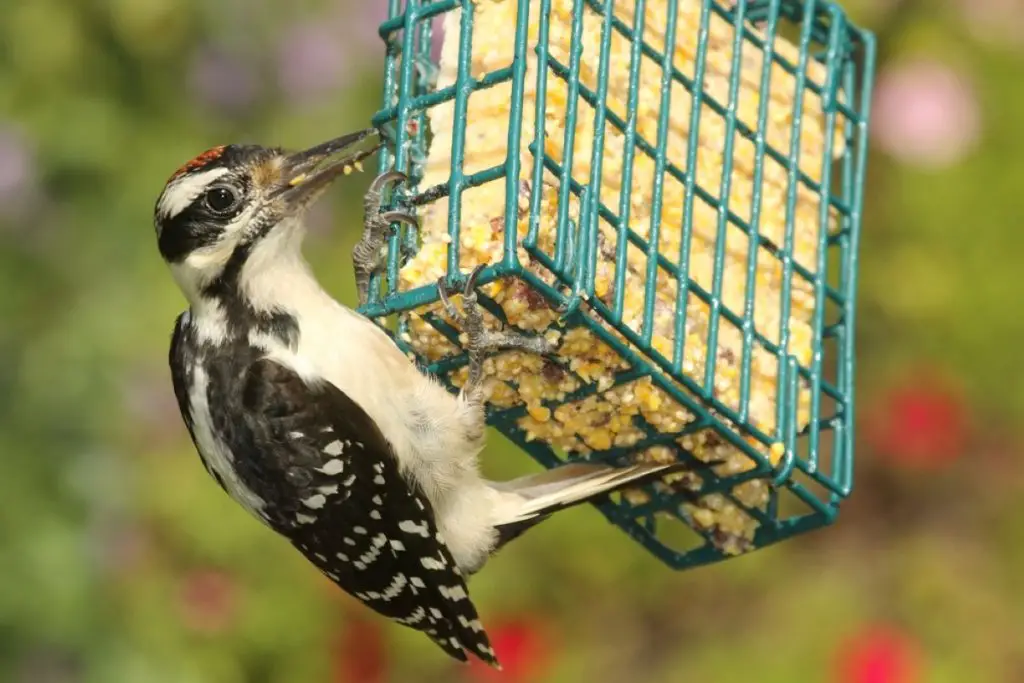
What Type of Bird Feeder Attracts the Most Birds?
The simple answer is platform feeders. A platform bird feeder tends to attract the most bird species and a diverse range of birds. Platform feeders, also known as tray feeders, are open and flat surfaces where birdseed, nuts, fruits, and other bird foods are spread out. These feeders are accessible from all sides, allowing multiple birds to feed simultaneously.
Other popular types of bird feeders – each suited for different types of birds – include:
Hopper Feeders: Hopper feeders have a seed reservoir with a tray or perch area where birds can access the seed. They are great for attracting songbirds like finches, chickadees, and sparrows.
Tube Feeders: Tube feeders have long, slender tubes with multiple feeding ports. They are excellent for attracting small clinging birds like finches and siskins. You can fill them with various seeds, such as nyjer seed for finches or mixed seeds for other species.
Suet Feeders: Suet feeders are designed to hold blocks or cakes of suet, a high-energy food made from animal fat. These feeders are especially attractive to woodpeckers, nuthatches, and other insect-eating birds.
Thistle/Nyjer Seed Feeders: Thistle or nyjer seed feeders are designed specifically for dispensing tiny thistle or nyjer seeds. They are a favorite among finches, especially goldfinches.
Window Feeders: Window feeders are designed to attach to windows, allowing you to enjoy close-up views of birds from inside your home.
Should bird feeders be in the sun or shade?
If possible, place the bird feeder in an area that receives both sun and shade throughout the day. This way, birds can enjoy the warmth and visibility of the sun during cooler periods and seek relief in the shade during the hottest parts of the day.
Position the feeder near natural sources of shade, such as trees or shrubs. This not only provides shade for the feeder but also offers cover for birds to rest and feel safe while they eat.
Having a nearby water source, such as a birdbath or fountain, can also attract birds and provide a place for them to cool off during hot weather.
Can Bird Feeders Attract Rats?
While squirrels tend to be regular visitors to some bird feeders, rats shouldn’t be too involved in stealing bird food. However, unguarded feeders may be attractive for mice and rats. In addition, ground tray feeders may attract critters such as raccoons, chipmunks, or even deer.
Luckily, there are 2 things you can do:
- Keep rodents off the feeder.
- Place the feeder off the ground.
If you do want to keep the rats away, start by removing potential rat shelters around your house. This includes openings in buildings, debris piles, or stacked wood. You can also go extreme and place electrical traps to kill the rodents. Still, if you don’t take the food sources away, they’ll always come back.
Step two involves moving the feeder off the ground. Use pole-mounted feeders or window feeders to keep the food in the air. Add a dome baffle to additionally protect the feeder from rats. Plus, you can use the seeds rats aren’t fond of, but that might not get you all the bird species you wanted.
How To Attract Birds to the Feeder?
Start by offering variety. Don’t limit the food sources to seeds only. Include suet, sugar water, and fruits. Plus, use different feeders to boost your yard’s appearance.
Mix some peanut pieces and mealworms into the seeds. Alternatively, hang a separate peanut feeder. These are favorites among chickadees, nuthatches, brown creepers, woodpeckers, and fussy jays.
Use plants for shelter and nesting opportunities. Plant evergreen trees, bushes, vines, or ground covers around the feeder to give the birds some perching spots.
Combine Feeders With Bird Baths for More Visitors
After a hard day of setting up the feeders, remember that birds also need a water source. If you don’t live anywhere near a stream or a body of water, you can offer them bird baths. Bird baths can be a great source of fresh water and a place where birds refresh during hot days.
However, know that birds like some distance between their houses, feeders, and baths. If you can, separate the three for the ultimate enjoyment in your garden.
How do you clean bird feeders?
Regularly cleaning bird feeders is essential to maintain the health of the birds and prevent the spread of diseases.
Here’s a step-by-step guide on how to clean bird feeders effectively:
- Gather supplies: You’ll need a few items to clean the feeder properly, including rubber gloves, a scrub brush or toothbrush, mild soap or dish detergent, a bucket, and clean water.
- Empty the feeder: Before starting the cleaning process, remove all remaining birdseed and debris from the feeder. Dispose of any spoiled or moldy seeds.
- Disassemble the feeder: If your feeder has removable parts or perches, take them apart to clean each component thoroughly. This will ensure that all areas of the feeder are cleaned and sanitized.
- Soak the parts: Fill the bucket with warm water and add a few drops of mild soap or dish detergent. Place the feeder components in the soapy water and let them soak for at least 10-15 minutes. Soaking helps loosen dirt and grime, making it easier to clean.
- Scrub the feeder: Use the scrub brush or toothbrush to clean the feeder thoroughly. Pay close attention to any nooks, crevices, or feeding ports where dirt and bacteria may accumulate.
- Rinse with clean water: After scrubbing, rinse all parts of the feeder with clean water. Make sure to remove all traces of soap to avoid harming the birds.
By following these steps and maintaining a clean bird feeder, you’ll create a healthier environment for the birds and increase the chances of attracting a variety of beautiful bird species to your backyard.

